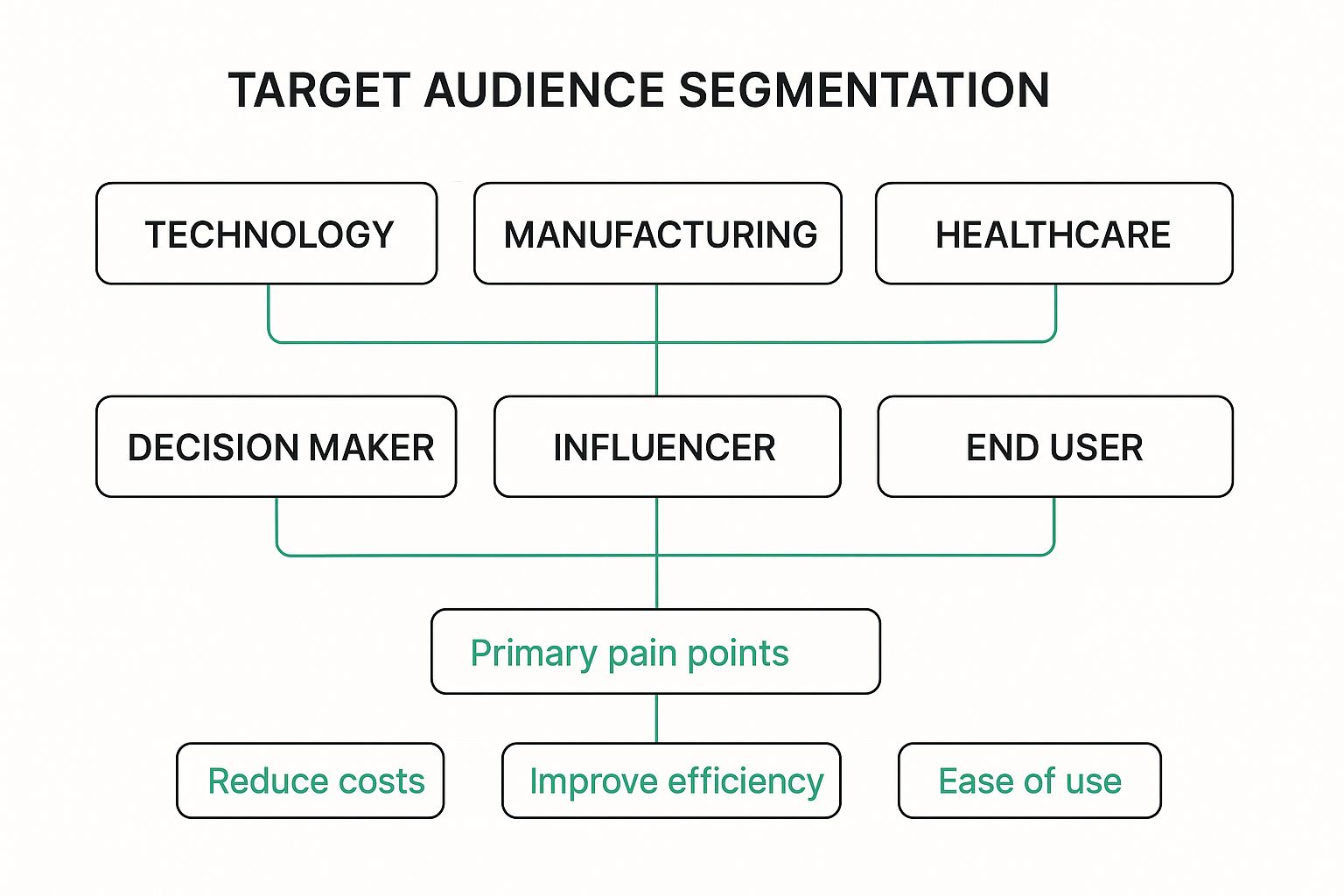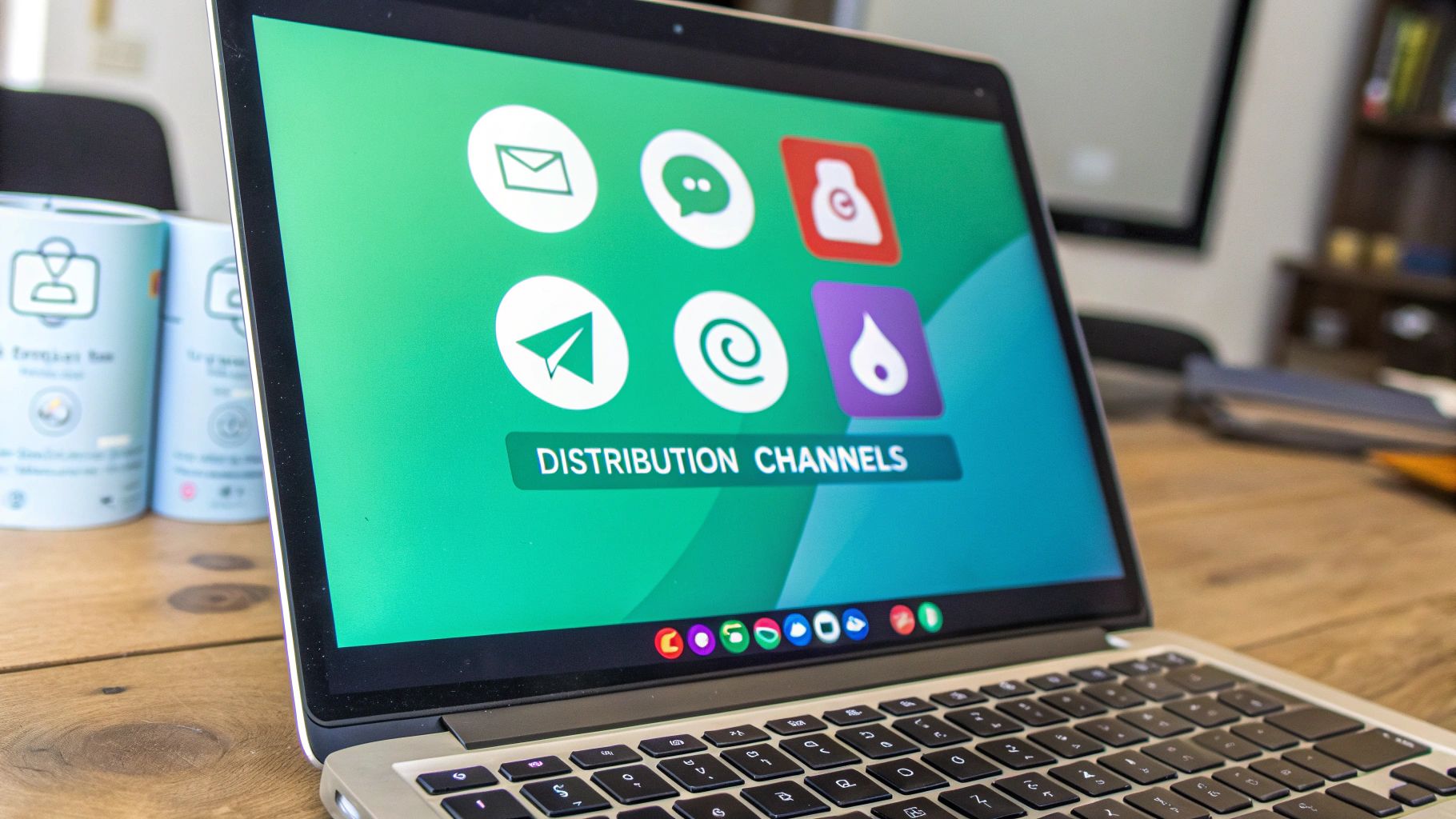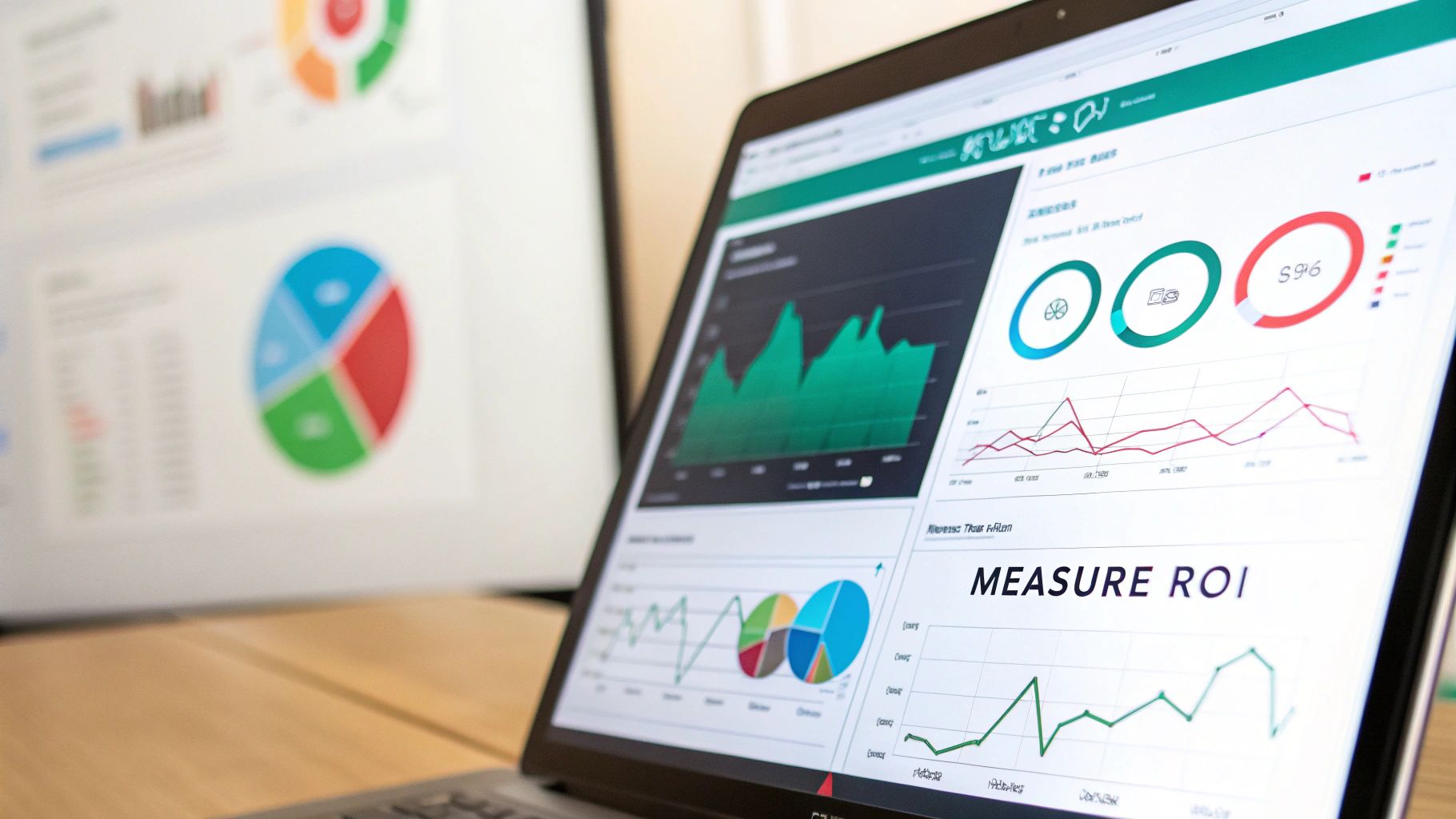B2B Content Marketing Strategies That Convert
Effective B2B content marketing strategies aren't just about cranking out blog posts. Think of it as a complete system for building authority, educating your ideal buyers, and opening a direct line to decision-makers long before a sales call is even on the radar. It’s the engine that pulls high-value clients toward your brand, so you can stop chasing them down.
Why B2B Content Is Your Strongest Growth Lever
Let's be honest, the old playbook of cold calls and endless email blasts is broken. Traditional outbound sales often feels like you're just knocking on random doors, hoping someone’s home and happens to be in a buying mood.
A modern content strategy flips that entire model on its head. Instead of chasing, you build something people want to visit—a landmark digital headquarters, if you will.
This headquarters is open 24/7, offering up valuable insights, solving complex problems, and showing off your expertise without being pushy. Every article, white paper, and webinar you publish acts as a helpful guide, building trust and credibility with each little interaction. This approach systematically nurtures relationships with potential buyers, making your company the obvious choice when they’re finally ready to pull the trigger.
From Cost Center to Revenue Driver
Too many businesses get this wrong. They see content as just another marketing expense on a spreadsheet. But when you do it right, content becomes a powerful and predictable revenue driver. Unlike a paid ad that vanishes the second you stop feeding it money, a great piece of content can keep generating leads for years.
The real shift happens when you stop thinking about "blog posts" and start thinking about building a library of strategic assets. Each asset has a specific job to do at different stages of the buyer's journey:
- Top-of-Funnel Content: These are your articles and infographics. Their job is to build awareness and attract a wide audience of people who are just starting to research their problems.
- Middle-of-Funnel Content: Here’s where your in-depth guides, webinars, and case studies shine. They educate qualified leads and start showing them exactly why your approach is different.
- Bottom-of-Funnel Content: Think demo videos and detailed product comparisons. This content is designed to give prospects that final nudge they need to choose you over the competition.
Remember, B2B buyers now do a huge chunk of their research on their own before they ever reach out to a vendor. Your content is your first salesperson—and often your most important one.
By layering your content like this, you ensure you’re present and helpful at every critical moment. You’re not just selling a product anymore; you're providing the information and assurance that decision-makers need to feel confident in their choice. This is how B2B content marketing strategies stop being about simple brand awareness and become the most reliable engine for sustainable growth, cementing you as an industry authority that clients actively seek out and trust.
Building Your B2B Content Strategy Blueprint
Trying to create content without a solid plan is like sailing without a map—you'll be busy, but you won't get anywhere meaningful. A real blueprint for your B2B content marketing transforms random acts of content into a coordinated system, one designed to attract, engage, and ultimately convert your ideal customers. It all kicks off with knowing exactly who you're talking to.
Forget about those generic, fluffy personas. Instead, you need to get laser-focused on developing a detailed Ideal Customer Profile (ICP). An ICP isn't some made-up character; it's a specific description of the perfect company that needs your solution. You'll build this using firmographics like industry, company size, and annual revenue.
Once you have the company profile locked down, you can pinpoint the key people inside those companies—the decision-makers, the influencers, and the end-users who will actually use your product.
This visual breaks down how you can segment your audience, starting from broad industries and narrowing all the way down to the specific pain points that keep them up at night.

This structured approach makes sure your content speaks directly to the real-world challenges that drive people in specific roles to look for a solution.
Set Goals That Actually Drive Business Outcomes
With a crystal-clear audience in mind, the next move is to set goals that matter. Vague objectives like "increase brand awareness" just won't cut it. Your goals need to be specific, measurable, achievable, relevant, and time-bound—what we all know as SMART goals.
For a B2B content strategy, this really means tying every piece of content you create to a tangible business result.
- Specific: Don't just "get more leads." Aim to "generate 50 new Marketing Qualified Leads (MQLs) from our blog content each quarter."
- Measurable: Use your analytics tools to track exactly how many MQLs are coming from content downloads or webinar sign-ups.
- Achievable: Look at your current performance. If you're getting 10 MQLs now, aiming for 50 is a stretch, but it's possible with a solid plan.
- Relevant: Make sure the goal supports bigger business objectives, like growing the sales pipeline by 15%.
- Time-Bound: Give yourself a deadline, like "by the end of Q3," to create a sense of urgency and a clear benchmark for success.
Setting these kinds of measurable goals is becoming standard practice. As businesses look toward 2025, having a documented content strategy is the norm, with most B2B marketers now having a formal plan. This structure is directly linked to better performance tracking and aligning content with real lead generation targets. You can see more on how B2B marketing trends are evolving on Statista.
Dominate Your Niche with Pillar Pages and Topic Clusters
If you want to establish real authority and rank well in search engines, you need a structured approach to your topics. This is where the pillar page and topic cluster model comes in—it’s a powerful way to organize your content. Think of it as building the ultimate, go-to resource on a core subject that matters to your ICP.
A pillar page is a comprehensive, long-form piece of content that covers a broad topic, like "AI Lead Generation." The topic clusters are shorter, more specific articles that dive into subtopics and all link back to the main pillar page. These could be articles like "How to Use AI for Sales Prospecting" or "Top AI Lead Scoring Tools."
This model does more than just organize your content; it sends a strong signal to search engines that you have deep expertise on a subject. By interlinking the pillar and its cluster pages, you create a powerful web of content that boosts your authority and makes it incredibly easy for potential buyers to find comprehensive answers to all their questions.
This strategic organization doesn't just do wonders for your SEO. It also guides your audience through a logical learning path, building their trust in your brand every step of the way. For a great example of how this works in practice, check out our complete guide to AI lead generation tools.
When you build this kind of blueprint, your B2B content marketing finally has clear direction and purpose, ensuring every article, video, and guide you create is working hard to hit a defined business goal.
Creating Content That Engages Decision Makers
Let's be blunt: sophisticated B2B buyers have zero patience for generic, surface-level content. They're busy decision-makers hunting for genuine insights, not another fluffy listicle. This means your B2B content marketing strategies have to be built on depth and credibility, not just sheer volume. The goal isn't just to attract attention, but to build unwavering trust.
This is where you graduate from standard blog posts to high-impact formats that truly connect with an executive audience. While blogs are great for building awareness, decision-makers often need more substantial proof before they'll even consider a solution. The kind of proof that comes from well-researched, authoritative content that your competitors can't just spin up overnight.

Go Beyond the Blog Post
If you want to grab the attention of a C-suite executive or a technical buyer, your content needs to feel less like a blog and more like a valuable consultation. That means leaning into formats that showcase deep expertise and offer unique perspectives they can't find anywhere else.
Here are three powerful content types to build your strategy around:
- In-Depth White Papers: These aren't glorified sales brochures. A great white paper makes a well-researched argument, diagnoses a complex industry problem, and offers a new framework for solving it. It should be packed with data and present a viewpoint your readers haven’t seen before.
- Original Research Reports: Nothing builds authority faster than becoming the source. Conducting your own surveys or analyzing industry data positions your brand as a primary source of information, earning you valuable backlinks and media mentions.
- Compelling Case Studies: Decision-makers want proof, plain and simple. Case studies deliver by telling a relatable story of how a real customer conquered a specific challenge using your solution. A strong case study focuses on the customer's journey and uses hard data to show the tangible results.
The most effective B2B content doesn't just explain what to do; it demonstrates a profound understanding of the buyer's world and proves you have the expertise to solve their specific, high-stakes problems. This is a far cry from the old days, as modern buyers have made it clear that cold outreach doesn't work anymore.
Unlock Your Internal Expertise
Your company's greatest content asset isn't a writer—it's your internal Subject Matter Experts (SMEs). These are the engineers, product managers, and customer success leads who live and breathe your customers' problems every single day. Their insights are authentic, specific, and impossible for your competitors to copy.
Don't ask them to write articles. Interview them. A single 30-minute conversation with an SME can provide enough raw material for a white paper, a handful of blog posts, and a dozen social media updates. This approach respects their time while extracting the gold that will set your content apart. To amplify your content's impact even further, it's worth exploring how you can start leveraging AI for engagement and brand awareness.
Maximize Reach Through Content Repurposing
Creating one major asset, like a research report or a comprehensive webinar, is a big investment. The key to maximizing your ROI is to treat that "pillar" asset as the starting point, not the finish line. A smart repurposing strategy can turn one big piece of content into a month's worth of micro-content.
Here’s how you could break down a single 60-minute webinar:
- Video Clips: Chop up the most impactful 1-2 minute segments for LinkedIn and X (formerly Twitter).
- Blog Post Series: Transcribe the webinar and turn key sections into a series of detailed blog posts.
- Infographic: Visualize the key stats or the step-by-step process discussed in the presentation.
- Quote Graphics: Pull out powerful quotes from the speaker to share across your social channels.
- SlideShare Presentation: Upload the presentation deck to SlideShare to reach a whole new audience.
This is all about working smarter, not harder. Content marketing is still a core pillar for B2B brands, with recent research showing 83% of efforts are focused on building brand awareness and trust. With the average top-ranking article clocking in at around 1,447 words, the demand for deep, valuable content is obvious. It also explains why 84% of businesses now outsource creation to ensure they're delivering quality. By repurposing, you meet this demand for depth while ensuring your insights reach the widest possible audience.
Getting Your Content Seen by the Right People
Let's be honest. Creating exceptional content is only half the battle. If that brilliant white paper or insightful webinar never reaches the right decision-makers, its value plummets to zero. A great B2B content strategy lives and dies by its distribution plan. You have to be deliberate about cutting through the noise.
Think of your content as a valuable shipment. You wouldn't just leave it on the loading dock hoping someone stumbles upon it. You'd map out the most efficient routes to make sure it gets where it needs to go. Distribution is that crucial delivery system, turning your content from a static file on your server into an active, lead-generating machine.
A multi-channel approach isn't just a good idea; it's your best insurance policy. Putting all your eggs in one basket, like relying solely on organic search, is a risky game. By spreading your efforts across different platforms, you amplify your reach, reduce your dependency on any single channel, and meet your buyers where they're already spending their time.
Master Your Core B2B Distribution Channels
While you could chase dozens of platforms, a few consistently deliver the goods for B2B marketers. It's much smarter to focus your energy on these core channels, master their nuances, and build real momentum, rather than spreading yourself too thin.
The most effective distribution plans are really built on three pillars:
- Organic Search (SEO): This is your foundation for long-term, sustainable traffic. When you optimize your content for the right keywords—especially long-tail phrases that signal a user is ready to buy—you attract people who are actively looking for the solutions you provide. SEO is a marathon, not a sprint, but the compounding returns are impossible to beat.
- LinkedIn: As the definitive professional network, LinkedIn is simply non-negotiable for B2B. It’s the perfect place to share thought-leadership articles, jump into industry discussions, and connect directly with decision-makers at your target accounts.
- Targeted Email Marketing: Your email list is one of the few marketing assets you truly own. Nurturing your subscribers with exclusive content, insightful newsletters, and helpful resources gives you a direct line of communication to guide them through their buying journey.
When you integrate these channels, you create a powerful flywheel effect. An SEO-optimized article can be promoted on LinkedIn to spark initial buzz, which then drives email sign-ups for continued nurturing. This ecosystem makes sure your content is always working for you.
Tailor Your Content for Each Platform
One of the biggest mistakes marketers make is just blasting the same message everywhere. It doesn't work. Each platform has its own culture, its own formats, and its own audience expectations. To really make an impact, you have to adapt your content to fit the context of the channel.
For instance, that 2,000-word guide you just published on your blog? Don't just copy-paste the whole thing into a LinkedIn post. That's a recipe for getting ignored.
Instead, you should:
- For LinkedIn: Pull out a key insight, a compelling statistic, or a provocative question from the guide. Craft a short, engaging post around that one idea and then link back to the full article for anyone who wants to dive deeper.
- For Email: Send a newsletter that summarizes the main takeaways. Frame it as an exclusive resource for your subscribers, highlighting exactly how it solves a specific pain point they're dealing with.
The core principle is simple: provide value in the native format of the platform. By tailoring your message, you respect the user's experience and significantly increase the likelihood of engagement.
This customized approach is critical for grabbing attention in an incredibly crowded market. The global content marketing industry is exploding, with some projections showing it could hit $2 trillion by 2032. That growth highlights the intense competition for your audience's time, making intelligent distribution more vital than ever. You can dig into more content marketing trends on Blogging Wizard.
Accelerate Reach with Paid Promotion
While organic distribution builds a strong, long-term foundation, paid promotion is the jet fuel you need to accelerate your reach and guarantee visibility with key accounts. Platforms like LinkedIn Ads let you bypass the algorithm and put your best content directly in front of a highly specific audience.
You can target users by job title, industry, company size, and even the names of specific companies. This makes it a fantastically efficient way to support account-based marketing (ABM) campaigns or to jumpstart lead generation for a new piece of content. Even a modest budget can ensure your most valuable assets—like an original research report or a major case study—reach the exact people you need to influence. Pairing this with a solid organic strategy is fundamental, as you can discover in this beginner's guide to B2B lead generation.
How to Measure B2B Content Marketing ROI
You've poured time, energy, and resources into creating fantastic content. That’s a huge investment. But how do you prove it's actually making a difference to the bottom line? Measuring the return on investment (ROI) of your B2B content marketing isn’t about chasing surface-level numbers; it’s about connecting every blog post, white paper, and webinar to real business growth.
This is the step that turns your content from a creative project into a reliable revenue driver.

It’s easy to get bogged down in vanity metrics—things like page views, social media likes, or follower counts. While these numbers might feel good, they don't tell the full story. They don't answer the one question your CFO really cares about: "Is this content helping us close deals?"
To get a clear picture, you have to dig deeper and focus on the data that truly matters to your sales team and leadership.
Connecting Content to Commercial Outcomes
The real goal is to see exactly how your content nudges a prospect along their entire journey, from their first click to the final handshake. This means shifting your focus away from simple traffic numbers and toward metrics that show genuine business impact. It’s all about answering the question, "Did this piece of content help us win a new customer?"
Here are the key performance indicators (KPIs) that actually tell you something useful:
- Lead Quality: Are the people downloading your content (like an ebook or a guide) turning into real opportunities for your sales team? A high conversion rate from a Marketing Qualified Lead (MQL) to a Sales Qualified Lead (SQL) is a fantastic sign that your content is hitting the mark.
- Pipeline Influence: Dive into your CRM and see how many deals in your pipeline have touched your content. You might discover that prospects who read your case studies or watched a product demo are far more likely to sign on the dotted line.
- Customer Acquisition Cost (CAC): Killer content can seriously bring down your CAC over time. By attracting organic leads, you become less reliant on pricey ad campaigns, which makes every new customer you win that much more profitable.
- Sales Cycle Length: When you provide high-quality, educational content, you empower prospects to answer their own questions and move through the buying process faster. Track the average time it takes for a lead who came from your content to become a customer—you might be surprised at how much you're speeding things up.
To really nail this, a solid grasp of B2B marketing attribution is non-negotiable. It’s the only way to accurately connect your marketing efforts to actual revenue.
Your Essential Measurement Toolkit
The good news? You don't need a massive budget to track these metrics effectively. A few core tools, used in tandem, can give you a surprisingly complete view of your content's performance and its contribution to revenue.
Your measurement stack should at least include:
- Google Analytics: This is your home base for understanding traffic sources, user behavior, and on-site engagement. Make sure you set up conversion goals to track meaningful actions, like form fills or demo requests.
- Google Search Console: This tool is your window into organic search performance. It shows you which keywords are actually driving traffic and where you have opportunities to climb the rankings.
- Your CRM (e.g., HubSpot, Salesforce): This is where the magic happens. By integrating your CRM with your marketing platform, you can draw a straight line from the content a prospect consumed to the deal your sales team just closed.
A data-driven feedback loop is your most powerful asset. Regularly analyzing performance data allows you to double down on what’s working, fix what isn’t, and continuously refine your B2B content marketing strategies for maximum impact. This is how you build a resilient, high-performing content engine that consistently delivers measurable results.
What's Next? A Look at Emerging Trends in B2B Content Marketing
What gets you results today might not cut it tomorrow. That's just the reality of marketing. If you want to build a strategy that lasts, you have to keep one eye on the future. This isn’t about throwing out the playbook—it’s about upgrading it with new tech and a sharper understanding of what your buyers actually want.
Staying ahead means paying attention to the trends that are reshaping how B2B relationships are built.

It’s time to look past the static blog post and embrace content that’s dynamic, personal, and community-focused. The most successful B2B content marketing strategies will be the ones that feel less like a broadcast and more like a series of helpful, one-on-one conversations powered by smart technology.
AI as Your Content Co-Pilot
Let's get one thing straight: AI is not here to replace skilled content marketers. Its real strength is as a co-pilot, a tool that enhances human expertise to help you scale production, dig deeper in your research, and find insights you might have missed. Smart marketers are using it to handle the grunt work so they can focus on what matters—strategy and creativity.
Think of AI’s role in a few key areas:
- Supercharged Research: AI tools can tear through massive amounts of data in minutes. They can spot competitor content gaps, find emerging keywords, and analyze customer sentiment trends that would take a human researcher days to uncover.
- Ideation and Outlining: Stuck for ideas? Feed AI your core topics and audience profiles, and you can get back hundreds of relevant content ideas and structured outlines. It's a great way to beat writer's block and make sure you're covering a topic from every important angle.
- Generating First Drafts: AI can produce a surprisingly solid first draft of an article or white paper. This frees up your subject matter experts to spend their time refining the story, adding their unique insights, and making sure the final piece truly sounds like your brand.
Hyper-Personalization for ABM
Account-Based Marketing (ABM) is all about quality over quantity, and its success rides on hyper-personalization. Generic content blasts just don't work when you're trying to land high-value accounts. The shift is toward creating content specifically tailored to the challenges, industry, or even the individuals within a single target company.
This could be as specific as creating a custom case study that mirrors a prospect's exact situation or a personalized landing page that greets them by name and speaks directly to their known pain points. This isn't just clever marketing; it shows you've done your homework and you're serious about solving their problem.
Hyper-personalization is the ultimate signal that you see your prospect as a partner, not just another lead in the pipeline. It transforms your content from a monologue into a direct, relevant dialogue.
The Rise of Interactive Content and Community
Let’s face it, B2B buyers are tired of being passive consumers of content. They want to engage, to interact, and to get immediate value. This has led to a surge in formats that invite people to participate.
- Interactive Tools: Think quizzes, ROI calculators, and solution configurators. These aren't just gimmicks. They engage the user on a deeper level and, in the process, capture incredibly valuable first-party data that can arm your sales team for much more relevant conversations.
- Community Building: The smartest brands are building communities around their content, like dedicated Slack channels or private forums. These spaces give customers and prospects a place to connect, ask questions, and learn from each other—with your brand right at the center of it all.
Frequently Asked Questions
Let’s be honest, navigating the world of B2B content can feel like you’re trying to solve a puzzle with half the pieces missing. When you're trying to prove its value and get a new strategy off the ground, a lot of questions come up.
Here are some straight answers to the most common challenges we see marketers face when they're getting their B2B content marketing strategies up and running. Think of this as your quick guide to clearing those practical hurdles, from getting internal support to figuring out a publishing schedule that won't burn you out.
How Do I Get Buy-In from Leadership?
Getting executives on board is all about speaking their language. And their language is business results, not marketing metrics. Forget talking about traffic and engagement for a minute; you need to frame your content strategy in terms of its impact on the bottom line.
When you make your pitch, focus on the outcomes they actually care about:
- Lead Generation: Show them exactly how your content will generate Marketing Qualified Leads (MQLs) for the sales team.
- Sales Enablement: Explain how things like case studies and white papers will arm sales reps to close deals faster.
- Customer Acquisition Cost (CAC): Make the case that a strong organic presence will cut down your reliance on expensive paid ads over time.
Come prepared with a clear plan, defined KPIs, and a realistic timeline. When you can draw a straight line from your content to revenue goals, you shift the conversation from a cost center to a strategic investment.
How Do I Calculate Content Marketing ROI?
Calculating a precise ROI for content can feel a bit fuzzy, but it's totally doable if you approach it the right way. The trick is to stop obsessing over vanity metrics and start connecting content consumption to real actions in your sales funnel.
The simplest way to think about it is this: track the revenue that came from leads who first found you through your content, subtract what you spent creating and distributing it, and then divide that by your initial cost. For instance, if you brought in $50,000 in new business from content leads and spent $10,000 to make it happen, your ROI is a solid 400%.
To get this data, you'll need to use tracking tools like Google Analytics conversion goals and a CRM that can attribute new deals back to specific content downloads or blog visits. This gives you the hard numbers you need to prove your strategy is worth every penny.
What Content Should We Create First?
When you’re just starting out, the sheer number of content possibilities can be paralyzing. The best place to begin is at the bottom of the funnel—with assets that directly help your sales team and target buyers who are already kicking the tires.
Focus your initial energy on creating:
- Compelling Case Studies: Show off how you've already helped customers solve a big, painful problem.
- Detailed Product Pages: Answer every single question a potential buyer could possibly have about your solution.
- Clear Comparison Guides: Show prospects exactly how you stack up against the main competitors they're looking at.
This approach gives you an immediate win by helping your sales team close deals that are already in the pipeline. Once you have these foundational pieces locked in, you can start building out your top-of-funnel content to draw in new audiences.
How Often Should We Be Publishing Content?
There’s no magic number here. The truth is, consistency is far more important than volume. A chaotic approach where you publish five articles one month and then go silent the next will completely kill your momentum. It’s always better to publish one high-quality, deeply researched article every week than it is to churn out five mediocre ones.
Start with a pace you know you can realistically stick to. For most B2B companies, publishing 1-2 new, substantial pieces of content per week is a great goal. It’s frequent enough to keep your audience engaged and let search engines know your site is active, but not so much that you have to sacrifice the quality B2B decision-makers expect.
Ready to find high-intent leads who are actively discussing their problems online? Intently uses AI to monitor conversations on Reddit, X, and LinkedIn, delivering real-time alerts when potential customers need your solution. Stop guessing and start engaging with qualified buyers today. Find your next customer at https://intently.ai.
